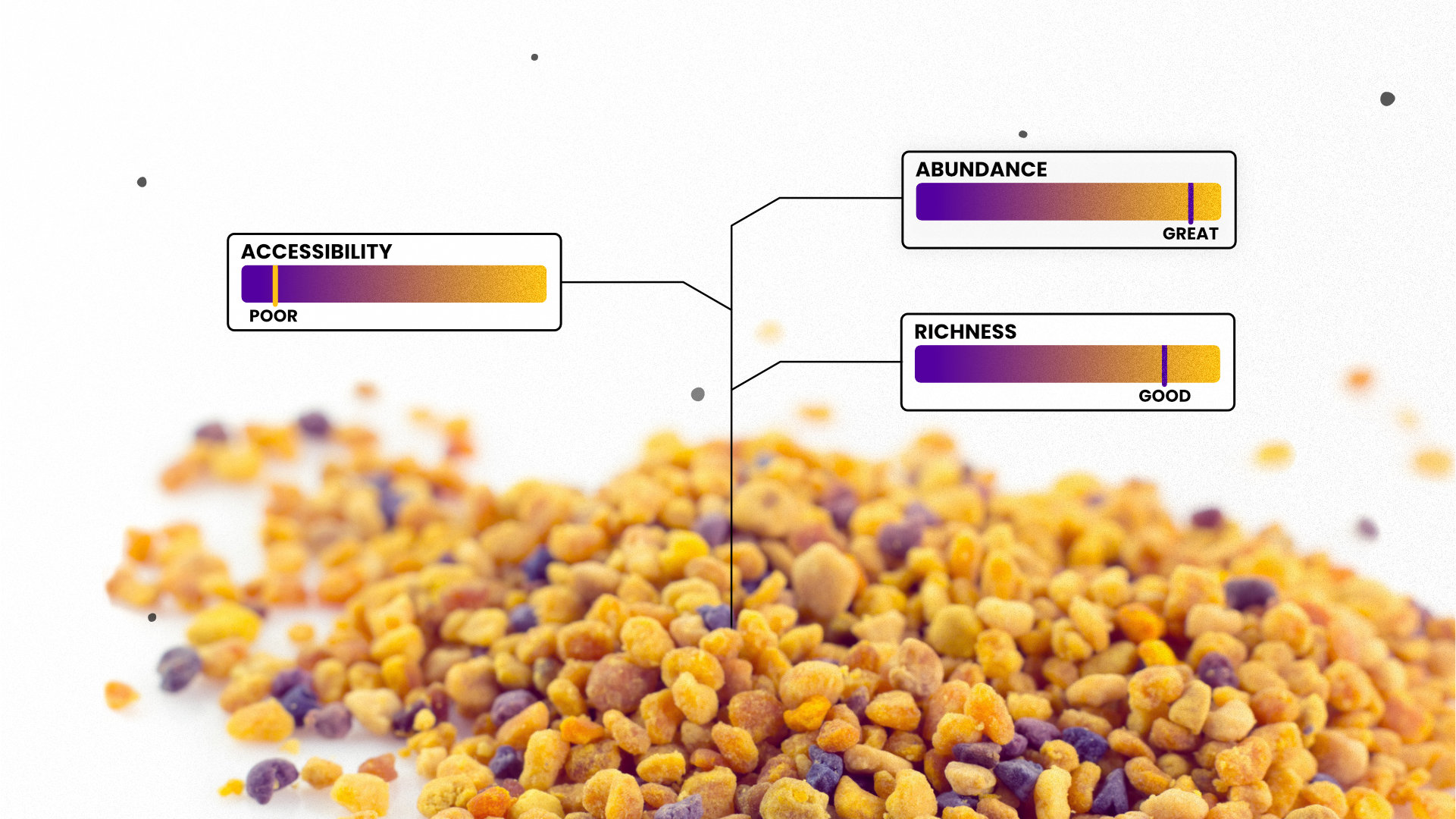Honeybees are remarkable creatures, and their pollen-gathering habits offer valuable insights into the health of our ecosystems.
A groundbreaking study involving 750 beekeepers across Europe analyzed 18,000 pollen samples collected by honeybees. Each sample weighed around 20 grams (equivalent to 2,000–2,500 pollen pellets). This large-scale analysis revealed a striking and consistent pattern in pollen colors:
- Four abundant colors: More than 20 pellets per color.
- One rare color: Between 3 and 20 pellets.
- One very rare color: Fewer than 3 pellets.
Two critical indicators of environmental health
The study helps us establish two key and robust metrics that translate honeybee foraging behavior into indicators of ecosystem quality:
- Pollen diversity: A healthy ecosystem provides six distinct pollen colors in a typical sample (four abundant, one rare, one very rare). Fewer colors or uneven distribution (e.g., only two abundant colors instead of four) signals significant deficiencies in floral diversity. While not a complete picture of all floral species and populations, this metric highlights gaps and challenges. As generalist foragers, honeybees’ inability to collect six colors strongly suggests a lack of environmental pollen diversity.
- Pollen accessibility: Accessibility measures how quickly honeybees can gather a diverse pollen sample. The study mention that in areas with abundant floral resources, bees collect their diverse sample more quickly. Conversely, longer collection times suggest they must travel greater distances to find the diversity they need, reflecting habitat degradation or insufficient floral density.
These indicators not only reveal the availability of floral resources but also provide a window into broader environmental conditions affecting pollinator health and biodiversity.
The role of the Onibi™ system in biodiversity monitoring
What if the 6000 hours spent by this research project, manually analyzing pollen samples, could be replaced by an automated system? That’s the transformative potential of the Onibi™ watch. This state-of-the-art device revolutionizes biodiversity monitoring by autonomously analyzing pollen samples and categorizing their colors. It replicates the precision of large-scale studies without requiring human intervention—and without taking away honeybees’ vital pollen resources.
The data collected by the Onibi™ watch feeds into the Onibi™ insight platform, which generates two key indicators:
- Pollen diversity indicator: Reflecting richness (number of colors) and abundance (distribution of colors) of pollen. A lower score signals reduced pollen diversity—such as having only five colors instead of six, or just two abundant colors rather than four.
- Pollen accessibility indicator: This measures how quickly bees collect a diverse pollen sample, serving as a gauge for habitat quality. Faster collection times suggest plentiful floral resources, while slower times may indicate environmental challenges.To ensure accuracy, this metric adjusts for variables like bee health, weather conditions, and seasonal bloom patterns. By isolating these factors, we can focus solely on environmental pollen accessibility as the driving factor behind collection duration.
These indicators are evaluated against scientifically validated thresholds, alerting users when the environment falls short of healthy benchmarks. Additionally, these two indicators—along with others calculated by Onibi™ insight—are aggregated into a broader biodiversity score. This comprehensive metric provides an overarching view of ecosystem health around the monitored beehives.
Enhancing ecosystems with targeted action
When the Onibi™ system detects low pollen diversity, it empowers users to make meaningful changes. By identifying missing floral resources, users can plant regionally adapted, native flowers that attract a broader range of pollinators. This not only improves food access for honeybees but also supports wild pollinators, especially specialists that are more vulnerable to habitat loss.
The benefits extend beyond pollinators. A thriving pollinator population enhances soil health, carbon retention, and overall ecosystem resilience.
Tracking progress for long-term impact
The Onibi™ system isn’t just a monitoring tool—it’s a catalyst for ecological improvement. Users can track tangible progress over time:
- Pollen diversity: The appearance of new colors on diversity graphs indicates growing floral variety, while increased units of common colors suggest greater abundance. Better-distributed samples point to improved overall diversity.
- Pollen accessibility: Shorter collection times show that habitats are becoming richer and more supportive of pollinators.
- Overall biodiversity indicators: These reflect healthier, more resilient ecosystems.
With these insights, year-over-year improvements become measurable, driving long-term positive change for pollinators and the environments they sustain.
Why this matters: a scalable solution for biodiversity monitoring
Traditional biodiversity studies often require significant resources, making them difficult to scale. The Onibi™ system offers an affordable, efficient alternative by leveraging honeybee behavior as a natural data collection method. Its ability to provide continuous, ground-level insights complements manual fieldwork, bridging the gap between scientific research and practical action.
Whether you’re a conservationist, researcher, or sustainability manager, the Onibi™ system provides actionable information to protect, restore and report on biodiversity. It equips users with the tools to make informed decisions, fostering ecosystems that support pollinators and, by extension, all life that depends on them.
Take the next step
Are you ready to revolutionize your approach to biodiversity monitoring? Contact us to explore how the Onibi™ system can enhance your nature-positive projects and help create thriving ecosystems for pollinators and beyond.



